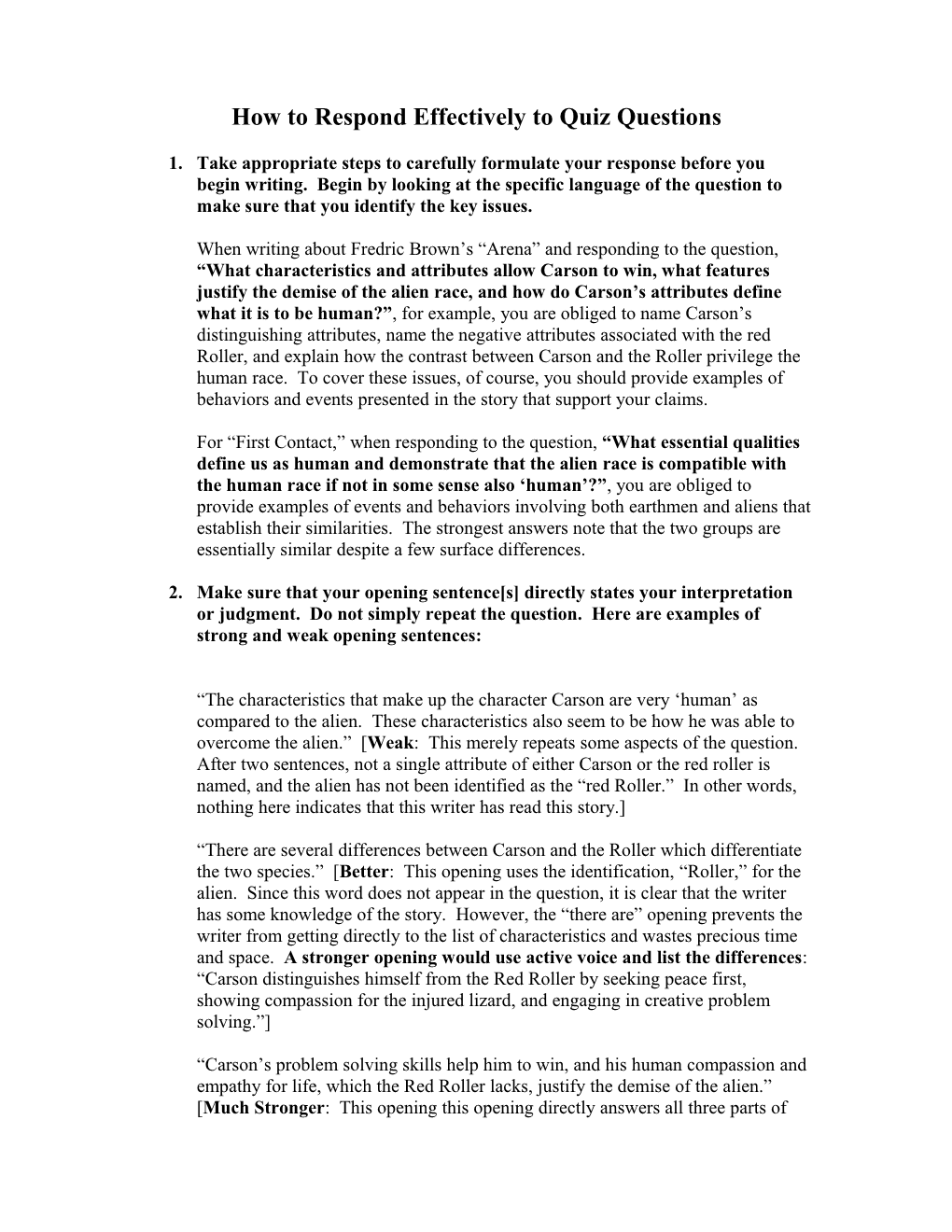How to Respond Effectively to Quiz Questions
- Take appropriate steps to carefully formulate your response before you begin writing. Begin by looking at the specific language of the question to make sure that you identify the key issues.
When writing about Fredric Brown’s “Arena” and responding to the question, “What characteristics and attributes allow Carson to win, what features justify the demise of the alien race, and how do Carson’s attributes define what it is to be human?”, for example, you are obliged to name Carson’s distinguishing attributes, name the negative attributes associated with the red Roller, and explain how the contrast between Carson and the Roller privilege the human race. To cover these issues, of course, you should provide examples of behaviors and events presented in the story that support your claims.
For “First Contact,” when responding to the question, “What essential qualities define us as human and demonstrate that the alien race is compatible with the human race if not in some sense also ‘human’?”, you are obliged to provide examples of events and behaviors involving both earthmen and aliens that establish their similarities. The strongest answers note that the two groups are essentially similar despite a few surface differences.
- Make sure that your opening sentence[s] directly states your interpretation or judgment. Do not simply repeat the question. Here are examples of strong and weak opening sentences:
“The characteristics that make up the character Carson are very ‘human’ as compared to the alien. These characteristics also seem to be how he was able to overcome the alien.” [Weak: This merely repeats some aspects of the question. After two sentences, not a single attribute of either Carson or the red roller is named, and the alien has not been identified as the “red Roller.” In other words, nothing here indicates that this writer has read this story.]
“There are several differences between Carson and the Roller which differentiate the two species.” [Better: This opening uses the identification, “Roller,” for the alien. Since this word does not appear in the question, it is clear that the writer has some knowledge of the story. However, the “there are” opening prevents the writer from getting directly to the list of characteristics and wastes precious time and space. A stronger opening would use active voice and list the differences: “Carson distinguishes himself from the Red Roller by seeking peace first, showing compassion for the injured lizard, and engaging in creative problem solving.”]
“Carson’s problem solving skills help him to win, and his human compassion and empathy for life, which the Red Roller lacks, justify the demise of the alien.” [Much Stronger: This opening this opening directly answers all three parts of the question and leads the writer directly to the specific details and events that will be presented to defend the generalizations stated in the topic sentence.]
- Here is a sample answer written by a student in this course. I modified it only to correct word choice and grammatical errors that probably resulted from quick writing in a quiz situation. I have used bold type in the answer to identify specific story details that justify my awarding a high score.
Carson possessed four main characteristics that led to his victory over the alien, who did not have the same qualities Carson exhibited. Carson used his intellectual ability to win the battle with the red roller alien. He was able to devise a plan once he figured out how the barrier worked to get across it. The alien, on the other hand, did not show as much intelligence, especially when it rebuilt the catapult after Carson had destroyed it. If the alien were smarter, it would have known that Carson could once again destroy that one. Carson also used superior mental ability. He understood the ways around the barrier and took the example of the lizard to understand that unconsciousness gets through. Carson showed persistence, which is a characteristic of the human race as well. He never gave up and continued his battle even though he was hurt, thirsty, and on the verge of death. Finally, Carson had strength. Even though strength was not the sole determinant of the battle, Carson had it and used it to go on. The alien did not possess many characteristics. It showed hatred and not much intelligence because it never tried to cross the barrier after it knew it was there. The alien’s demise resulted from lack of persistence and mental capability, along with Carson’s endurance and the chances he took by using the leaves for his wound and knocking himself unconscious to get to his victim.
Note that this response succeeds despite a weak opening sentence that does not identify Carson’s specific superior characteristics. Although I would not address the question in this way and a more carefully structured response would present the same details in a much briefer answer, this student scored well because the answer demonstrates knowledge of the story’s particulars while identifying specific differences between Carson and the Red Roller.
- Be prepared to use character names. Spend time recording character names in your memory. Be prepared to write “Tommy Dort” and “Buck” instead of “the human translator” and his “alien friend.” Using the characters’ names emphasizes your careful reading and thoughtful response to the assigned work. The names, especially if they do not appear in the question, function as supporting details.
- Avoid wordy delay structures and write in active voice; make your subjects act through your verbs in sentence openings. Here is some more detailed advice:
Avoid “There is,” “There were,” “There are,” “It happens that,” “One thing that I want to discuss is that…”, “Another example is…” and other wordy delay openings.
Avoid “I think that,” “I feel that…” and similar openings.
Avoid weak verbs as your main verbs: to be, to do, to make, to get, to have.
